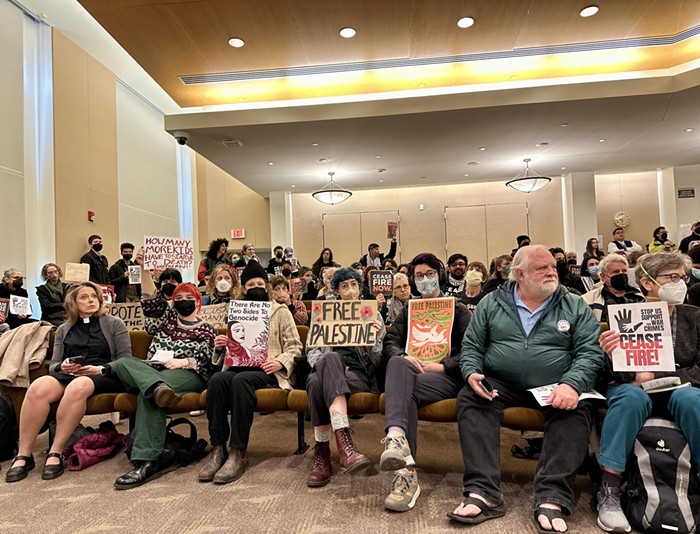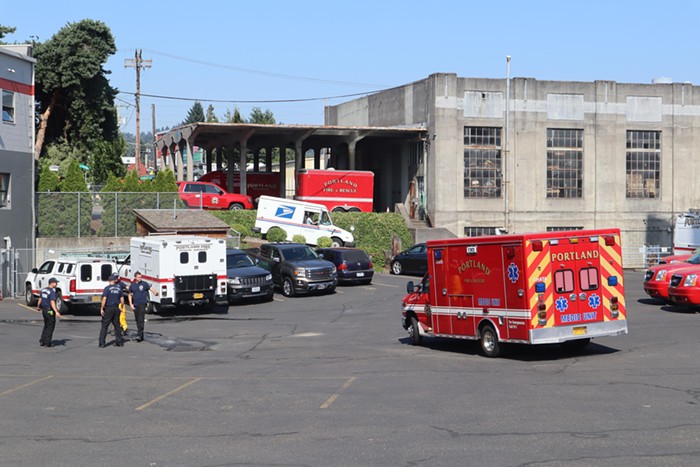FOR WEEKS this summer, Mayor Charlie Hales has led Portland's crackdown on the physical manifestations of homelessness—meeting privately with advocates and business interests while he publicly swept protestors from Portland City Hall and began rousting campers from other sites in and around downtown.
Deciding on stickier, longer-term solutions for homelessness—and, more importantly, finding the money to pay for those programs months after Portland finished cutting its budget—would have to wait until later.
That was the plan, at least. Until it wasn't.
Over the weekend, in an appearance on KGW's Straight Talk, Housing Commissioner Dan Saltzman announced an abrupt shift in the city hall conversation: He and Hales are now working up a $2 million spending plan on homelessness expected to go before their colleagues as soon as next month.
Half the money would be spent on homeless women, one of Saltzman's priorities, with some of the rest spent on one of the groups overwhelmingly targeted in the latest crackdown: kids living on the street.
The spending plan—sent from Saltzman to Hales on Thursday, August 15—amounts to a sudden reframing of an issue that's been focused, so far, on so-called "lawlessness" and Hales' vision for a vibrant city hall food cart pod.
Significantly, it came the day after Hales—bowing to intense political criticism first reported by the Mercury ["The Empty Throne," News, Aug 14]—finally invited Saltzman's staff, former Housing Commissioner Nick Fish, and experts in the city's housing bureau to one of his closed-door meetings on homelessness. The plan Saltzman submitted closely followed what advocates and others discussed.
"City hall and Multnomah County have a chance to turn this into a real opportunity for people experiencing homelessness and mental-health issues in our community," says Israel Bayer, executive director of Street Roots and a participant in that powwow.
But despite advocates' cautious embrace, talk about this kind of money—and so soon after his crackdown—probably wasn't what Hales had in mind.
_________________________________________________________________________________________
Dozens of pages of emails obtained by the Mercury as part of a public records request show Hales and his staff pouring intense amounts of energy into an evolving plan for sprucing up city hall's plaza and addressing sidewalk and camping violations downtown and elsewhere in the city. The emails also make clear that the new spending plan isn't the first time Hales—trying to run full tilt in one direction—has had to backtrack in the face of criticism.
As early as June, emails reveal discussions about adding music outside city hall—which, at the time, was home to an 18-month religious vigil and protest that had become, as temperatures warmed, a full-fledged campsite. The discussions were also well before a downtown store employee was hit on the head with a skateboard on July 15, giving groups like the Portland Business Alliance (PBA) cover to more loudly press the safety claims they'd been making for months.
Moreover, they also began well before the cops furnished Hales with a definitive tally of calls for service outside city hall.
"Can I ask the two of you to connect [regarding] music options in [the] plaza outside," Hales' chief of staff, Gail Shibley, emailed policy directors Josh Alpert and Noah Siegel on June 20.
Campers weren't mentioned then. But they became part of the subtext as those discussions intensified. By July 3, the city's facilities department was working up plans for a bioswale in front of city hall along SW 4th—a project that would undoubtedly force the clearing of the protest.
And Shibley wanted the proposal aired during Hales' regular meeting with Police Chief Mike Reese and Central Precinct Commander Bob Day. Later emails made the link explicit. By then it was clear—despite the office's protestations in the Oregonian that Hales merely wanted to tout the city's green credentials—that something more substantial was afoot.
Shibley, in fact, appears to be one of the central architects of Hales' vision. Much of the preparation, the emails show, ran through her inbox—although most of Hales' small cadre of senior staffers (Alpert, Siegel, and Ed McNamara) also were involved. City hall sources say that also fits what relatively little they'd seen as the process unfolded.
As early as July 9—nearly two weeks before the city posted notices warning campers to boot—the city's facilities boss, Bob Kieta, was emailing Shibley to talk about power-washing the sidewalks. His crew could "be ready," he told Shibley. But he worried about having to post notices and call cops to keep an eye on things—and made reference to a developing crackdown that had nothing to do with the environment.
"It may be best to wait for the [Portland Police Bureau] suggested action next week and coordinate our pressure wash with that," he wrote.
_________________________________________________________________________________________
Meanwhile, problems began cropping up. Designers had to rethink their plans for the bioswales to avoid cutting down trees. And politics were beginning to intrude.
Also on July 9, Dean Marriott, director of the Portland Bureau of Environmental Services (BES, the bureau that designs bioswales), wrote to Alpert and Fish's policy director, Jim Blackwood, with concerns. He didn't want to cross his boss, Fish, the commissioner in charge of the bureau.
"It appears there might be a disagreement in your building about how to proceed with this project," wrote Marriott, who reports to Fish, "or even proceeding period."
Blackwood replied the next day with Fish's order that BES put a "full stop" on the work until after he met with Hales' staff. Alpert, on July 9, wrote Shibley warning her that Fish's office "wasn't aware" of the bioswales, appending the word "Sorry!"
That meeting was planned for July 15. Fish later relented after extracting a promise that Hales wouldn't spend sewer rate money. But Fish's other concerns—which he waited to share for days—were clear. He warned the plan "will backfire."
"The pushback is related to not addressing the bigger issue on the sidewalks," Kieta wrote. "It will be very important to the success of this that we have him on board."
Within days, however, Hales' staff was ready to act—and growing excited. Hales personally wrote to his senior staffers, "So, we need to ROLL on our whole strategy... ASAP."
Shibley, the day after, told Kieta, "I can't tell you how much I look forward to being able to get coffee/juice and sit and meet with folks outside!"
But then came a fatal blow for one piece of the plan. Amid talk of posting campsite notices, but waiting to post construction notices—to avoid tipping off the public until designs were final—Commissioner Steve Novick joined Fish in resisting the bioswales. And after weeks of discussions, Hales' office, as reported by the Oregonian last month, shelved the idea of bioswales outside city hall. (Hales' office says they're still planned for SW 4th outside the Portland Building.)
The camping notices still went up—except that Hales' office no longer could conveniently blame sidewalk construction for the long-planned sweep. Instead, a few days later, the mayor's office held a press conference announcing a renewed emphasis on the city's sidewalk laws.
Hales' staff also began to get an inkling of how advocates and others might view their push. Suggestions to bring in social services providers and convene a group to discuss sidewalk policies weren't discussed until late in the process.
And before the city actually cleared the sidewalks on July 23, Alpert told Shibley and spokesman Dana Haynes that "as the media continues, it will be good to work into talking points" that providers were out before the notices went up.
The office also buzzed over an email—sent by Rob Justus, a former leader of homeless services agency JOIN—praising the sidewalk push as "the first step in bringing order to chaos large homeless camps bring."
"Wow," Haynes wrote to Shibley and McNamara. "This is great."
The campers moved to Chapman Square soon after. Then, in the face of Hales' camping push, they set up in federally owned Terry D. Schrunk Plaza. By Monday, August 19, dining tables and chairs had gone up outside city hall. And by the end of Monday, the feds had put up fences to renovate Schrunk Plaza, too.
The emails also turned up another interesting what-if.
In the midst of Hales' planning, the PBA offered to send a list of downtown blocks where it thought the city should ban sitting and lying down on the sidewalk. Hales' office acknowledges accepting the information, which called for placing a "high-volume pedestrian" designation on much of the downtown shopping district and on SE Hawthorne between SE 34th and 50th. Shibley had it sent on to the city's traffic engineers.
But Haynes says Hales has "no intention" of accepting the advice.
"We'd forgotten about it until you asked about it," he says.
Megan Doern, the PBA's spokeswoman, said the map was part of the PBA's ongoing lobbying on sidewalk issues and reiterated that Hales' office asked for whatever was sent over.
"Both the Alliance and the Clean and Safe District have been in discussions with the mayor's office about sidewalk behavior and ensuring that sidewalks are accessible," she says. "We've also discussed the need for additional services and how the business community, government, and nonprofit organizations can better partner and come up with solutions to facilitate more people getting to services and improve livability for everyone."
_________________________________________________________________________________________
Advocates still aren't happy with how the past few weeks have played out—and have long suspected that Hales' staff was pushing forward on a difficult issue despite doing only superficial planning.
But some also see the heavy-handed moves as a blessing in disguise. Without those moves, and the resulting backlash, city council might not be discussing a safety-net package this big. Advocates are even hoping Multnomah County matches some of the city's money with cash of its own.
"It's a win-win," says Bayer of Street Roots, "for people on the streets, government, law enforcement, and a concerned business community."



















